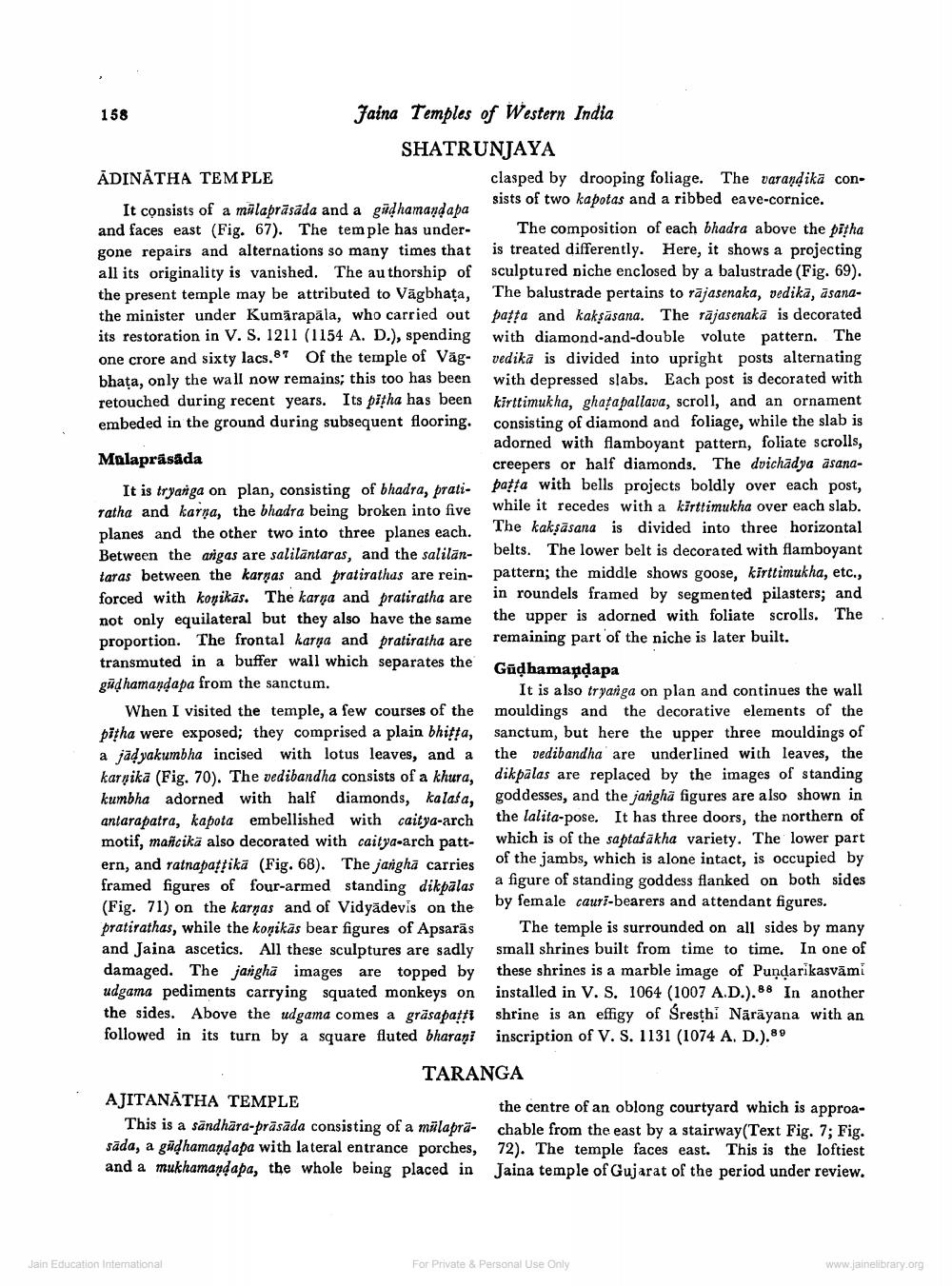________________
158
Faina Temples of Western India
SHATRUNJAYA ADINĀTHA TEMPLE
clasped by drooping foliage. The varandika con
sists of two kapotas and a ribbed eave-cornice. It consists of a malaprāsāda and a gūdhamandapa and faces east (Fig. 67). The temple has under. The composition of each bhadra above the pitha gone repairs and alternations so many times that is treated differently. Here, it shows a projecting all its originality is vanished. The authorship of sculptured niche enclosed by a balustrade (Fig. 69). the present temple may be attributed to Vāgbhata, The balustrade pertains to rājasenaka, vedika, asanathe minister under Kumarapala, who carried out patta and kaksäsana. The räjasenaka is decorated its restoration in V. S. 1211 (1154 A. D.), spending with diamond-and-double volute pattern. The one crore and sixty lacs.87 Of the temple of Văg- vedika is divided into upright posts alternating bhata, only the wall now remains; this too has been with depressed slabs. Each post is decorated with retouched during recent years. Its pitha has been kirttimukha, ghatapallava, scroll, and an ornament embeded in the ground during subsequent flooring. consisting of diamond and foliage, while the slab is
adorned with flamboyant pattern, foliate scrolls, Malaprasada
creepers or half diamonds. The dvichadya asanaIt is tryanga on plan, consisting of bhadra, prati
patta with bells projects boldly over each post, Tatha and karna, the bhadra being broken into five while it recedes with a kirttimukha over each slab. planes and the other two into three planes each. The kaksāsana is divided into three horizontal Between the angas are salilantaras, and the salilan
belts. The lower belt is decorated with flamboyant taras between the karnas and pratirathas are rein- pattern; the middle shows goose, kirttimukha, etc., forced with koņikās. The karya and pratiratha are in roundels framed by segmented pilasters; and not only equilateral but they also have the same the upper is adorned with foliate scrolls. The proportion. The frontal karya and pratiratha are remaining part of the niche is later built. transmuted in a buffer wall which separates the Gadhamandana gūdhamandapa from the sanctum.
It is also tryanga on plan and continues the wall When I visited the temple, a few courses of the mouldings and the decorative elements of the pitha were exposed; they comprised a plain bhitta, sanctum, but here the upper three mouldings of a jādyakumbha incised with lotus leaves, and a thevedibandha are underlined with leaves, the karnika (Fig. 70). The vedibandha consists of a khura, dikpalas are replaced by the images of standing kumbha adorned with half diamonds, kalata, goddesses, and the jarghā figures are also shown in antarapatra, kapota embellished with caitya-arch the lalita-pose. It has three doors, the northern of motif, mañcikä also decorated with caitya-arch patt
which is of the saptašākha variety. The lower part ern, and ratnapatřikā (Fig. 68). The jangha carries
of the jambs, which is alone intact, is occupied by framed figures of four-armed standing dikpalas
a figure of standing goddess flanked on both sides (Fig. 71) on the karnas and of Vidyādevis on the by female cauri-bearers and attendant figures. pratirathas, while the koņikas bear figures of Apsarās The temple is surrounded on all sides by many and Jaina ascetics. All these sculptures are sadly small shrines built from time to time. In one of damaged. The janghā images are topped by these shrines is a marble image of Pundarikasvāmi udgama pediments carrying squated monkeys on installed in V. S. 1064 (1007 A.D.).88 In another the sides. Above the udgama comes a grāsapatti shrine is an effigy of Sresthi Nārāyana with an followed in its turn by a square fluted bharani inscription of V. S. 1131 (1074 A. D.). 8 9
TARANGA AJITANATHA TEMPLE
the centre of an oblong courtyard which is approaThis is a sāndhara-prāsāda consisting of a mälaprä- chable from the east by a stairway(Text Fig. 7; Fig. sāda, a gūdhamandapa with lateral entrance porches, 72). The temple faces east. This is the loftiest and a mukhamandapa, the whole being placed in Jaina temple of Gujarat of the period under review.
Jain Education International
For Private & Personal use only
www.jainelibrary.org




